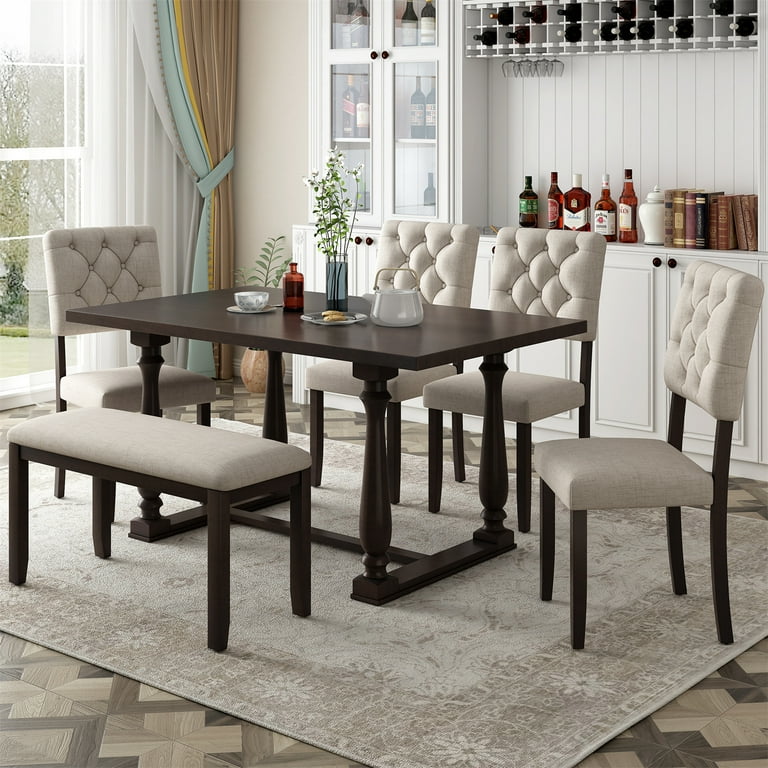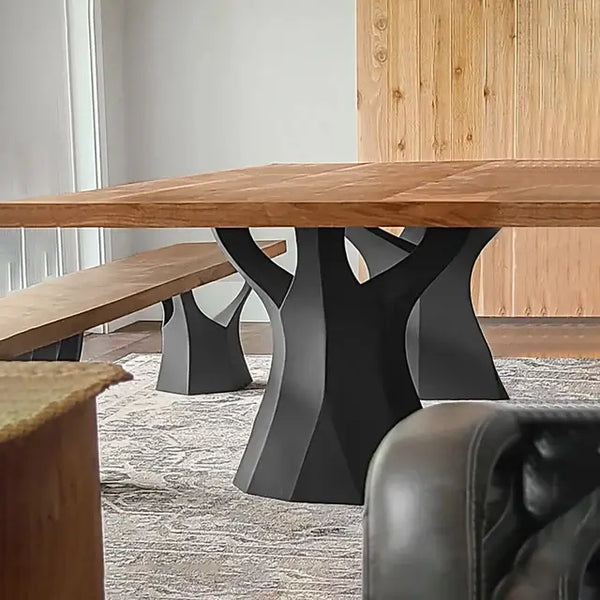From Typical to Modern: Discover the Suitable Dining-room Table Legs for Your Design
The choice of dining-room table legs plays a critical function in defining the general character of your space, linking the void in between conventional craftsmanship and modern looks. While classic designs such as cabriole and turned legs stimulate a feeling of timeless sophistication, modern designs like barrette and geometric choices offer an opportunity for striking visual interest. Examining the appropriate balance in between these styles calls for a nuanced understanding of your existing decoration and personal preference. As you think about these elements, the concern stays: just how can you effortlessly incorporate these varied leg designs to produce a harmonious dining experience?
Recognizing Table Leg Styles
The selection of dining-room table leg styles can significantly affect both the aesthetic appeals and capability of the space. Each leg style contributes special aesthetic aspects and useful features, satisfying diverse design choices and use demands. Recognizing these styles is crucial for selecting the appropriate eating table that aligns with your total interior style vision.
For example, tapered legs supply a tidy, traditional look that can boost a room's style, while stand bases give stability and make best use of legroom, making them suitable for smaller sized spaces. Hairpin legs, a characteristic of mid-century modern-day layout, present a commercial panache, enabling an airy, open feel. In a similar way, trestle legs evoke rustic charm, providing durable assistance and a feeling of eternity.
Furthermore, the option of materials plays a significant function. Wood legs can bring heat and structure, whereas metal options frequently share a streamlined, contemporary vibe. Eventually, recognizing table leg designs is important for producing a cohesive dining area that mirrors personal style while making certain practicality and comfort. By thoughtfully thinking about these components, you can enhance both the aesthetic and practical allure of your eating space.
Typical Table Leg Options
When picking dining-room table legs, traditional alternatives frequently personify classic beauty and craftsmanship. These styles reflect an abundant heritage and a commitment to top quality, making them excellent for those who value timeless aesthetics.
Among the most legendary typical leg designs is the cabriole leg, defined by its graceful curved form. This layout commonly features decorative makings and is most frequently found in Queen Anne and Chippendale furnishings. One more popular alternative is the transformed leg, which boasts a collection of smooth, rounded shapes that offer a traditional look while preserving security.
Moreover, the straight leg, while easy, uses a strong and basic structure that can mix flawlessly with a variety of tabletop styles. For those attracted to ornate detailing, claw-and-ball feet legs evoke a feeling of magnificence and can work as a spectacular centerpiece in any type of eating room.
Finally, pedestal bases, although not purely legs, give a different conventional option that enables adequate legroom and can be perfectly sculpted. Each of these typical leg designs adds to the total setting of a dining-room, marrying feature with visual allure.

Modern Table Leg Styles
Modern table leg layouts supply a diverse variety of designs that emphasize innovative materials and clean lines. These layouts often focus on capability while functioning as striking prime focus within an eating space. Minimal appearances prevail, with legs crafted from products such as metal, glass, and crafted timber, which add to a modern and ventilated feeling.
One popular design is the hairpin leg, defined by its slim, tapered framework that gives stability without frustrating the table top (dining room table legs). This style is commonly located in mid-century contemporary furniture and can easily complement numerous table forms. Another trend is making use of geometric shapes, where legs might handle angular or asymmetrical types, including aesthetic rate of interest and a touch of creativity

Blending Styles for One-of-a-kind Rooms
Often, home owners look for to produce one-of-a-kind eating areas that reflect their personal style by mixing numerous design aspects. This strategy permits the consolidation of varied aesthetic appeals, causing an unified yet distinct environment. As an example, pairing a rustic wooden table with smooth, modern-day steel legs can develop a distinctive comparison that boosts the room's overall charm.
Additionally, incorporating vintage table legs with contemporary table tops can evoke a feeling of history while maintaining a contemporary sensibility. Such combinations not just showcase individual preference yet likewise encourage imagination, enabling property owners to curate a room that feels both personal and inviting.
Color plays a critical role in this blending procedure; selecting table legs that enhance or visite site comparison with the existing color design can enhance visual interest. For instance, whitewashed legs can soften the daring of a dark table surface, developing a balanced aesthetic.
Tips for Selecting the Right Legs
Choosing the right table legs is important for attaining both functionality and visual appeal in your dining area. Begin by taking into consideration the general style of your space. Conventional settings gain from legs that feature detailed makings or transformed styles, while contemporary areas might call for streamlined, minimalist designs.
Next, assess find out the elevation and security of the legs. dining room table legs. Conventional table vary in between 28 to 30 inches in elevation, so make certain the legs enhance this dimension for comfort. In addition, durable materials, such as hardwood or metal, can boost stability and longevity
Evaluate the leg shape too-- options include straight, tapered, or stand designs. Straight legs use a timeless appearance, while tapered legs can include a touch of style. Pedestal bases supply enough legroom and are ideal for smaller rooms.
Final Thought
In summary, picking the optimal dining-room table legs needs mindful consideration of both contemporary and typical designs. Conventional choices such as cabriole and transformed legs provide classic beauty, while contemporary designs like barrette and geometric shapes offer a modern touch. By integrating leg style, height, and product with the total décor, a cohesive and welcoming environment can be achieved. Inevitably, the picked table legs should reflect the preferred visual, improving the eating experience within the room.
The variety of dining space table leg styles can significantly affect both the appearances and functionality of the space. Inevitably, recognizing table leg designs is vital for creating a see this website natural dining location that shows individual design while ensuring functionality and convenience.One of the most legendary traditional leg styles is the cabriole leg, characterized by its graceful curved shape. Straight legs provide a timeless look, while tapered legs can include a touch of sophistication.In recap, picking the ideal dining area table legs needs mindful factor to consider of both typical and modern styles.